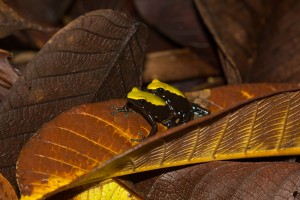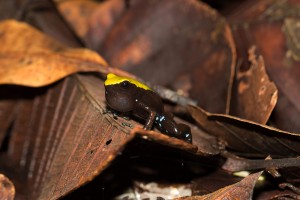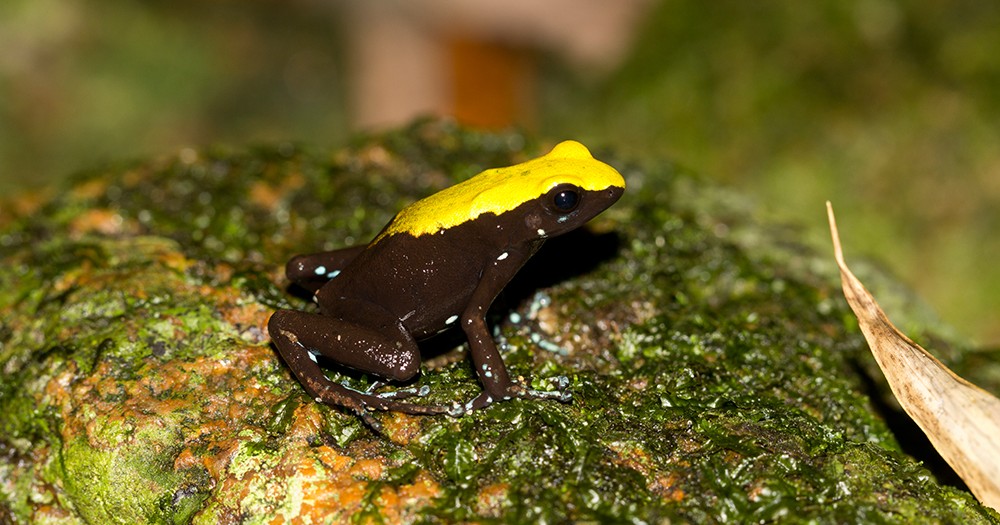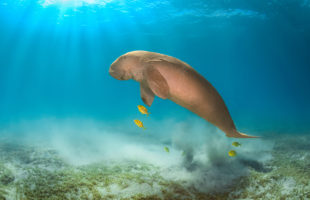Actually, Madagascan Mantellae all look very similar: Striking colours, small and slender, terrestrial frogs. But one steps out the line: The climbing Mantella (Mantella laevigata). This Mantella was described in 1913 by British zoologists Paul Ashleyford Methuen and John Hewitt, who did a seven months lasting expedition to Madagascar two years ago. The climbing Mantella grows up to maximally 29 mm and wears bright yellow colour at head and back, as well as blue spots on hands and feet. The rest of the frog is brownish black – so far, so similar to other Mantella. The colour is thought to repel natural enemies, such as birds or chameleons, and signals poison. Indeed Mantella produce a poisonous alcaloid in their skin, but it is completely harmless for humans.

Especially the island Nosy Mangabe, part of Masoala national park, is famous for its high incidence of climbing Mantellas. In March and October, you can watch these small frogs during the day en mass along the thick foliage layer, on tree trunks and mossy stems around the island. It occurs also in Marojejy national park, Mananara and Tsararano, but you will have much more difficulties to find a climbing Mantella there. It inhabits no other places worldwide.
The climbing Mantella is probably one of the best researched Mantella of Madagascar, surely thanks to its for Mantella unusual lifestyle. Indeed it is a terrestrial frog of rainforests like all Mantella, but in contrast climbs trees. It has been found up to four metres in height! Additionally, climbing Mantellas do not need streams or running water to reproduce and survive: That seems to be incredible for such a frog.
During breeding season at the beginning and the end of the rainy season, every male calls loudly at a egg laying place he selected himself. The call attracts females – but also other males. If another male approaches the chosen tree whole, they tend to fight for the place. Who defended his tree whole and a female successfully, fertilizes his Mantella’s eggs after a short amplexus. Egg laying is distinctly contrary in the climbing Mantella than in others of its kind: Instead of hiding a bunch of eggs deep in the foliage, the females glues only one egg – sometimes even two – some centimeters above the water in a small, water-filled tree trunk or bamboo hole. Sometimes the eggs dry out by the sun. But in those which develop successfully, you can watch an embryo from the second day on.

After some weeks, the tadpoles hatches and directly falls into the water beneath. It feeds on everything small enough that falls into the tree hole or bamboo trunk. Often the female climbing Mantella brings unfertilized eggs to its offspring as food. The male climbing Mantella rests nearby and defends the hole against intruders. Thus Mantella laevigata is the only Mantella of which we know such a parental care behaviour. It takes almost two months to grow from a tadpole to a complete frog, they are not full grown before on year. The adult climbing Mantellas feed on ants, termites and mites, but do not reject other tiny insects like flies.
IUCN lists this species as “near threatened” on its red list – together with the hint, that it might be on a higher threatening level in some years. The habitat of this small frog today is not larger than 20.000 km². Scientsists assume that this species cannot survive in destroyed areas after slash-and-burning or where cattle grazes. Only shelters like the island Nosy Mangabe will be able to keep this wonderful Mantella, so that people can gaze at it even in one hundred years from now. Since some years, the species has been keeping and breeding in captivity outside Madagascar successfully, too.
 MADAMAGAZINE Your Magazine about Madagascar
MADAMAGAZINE Your Magazine about Madagascar












